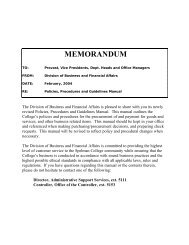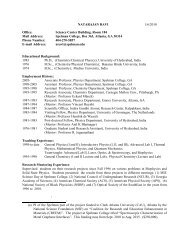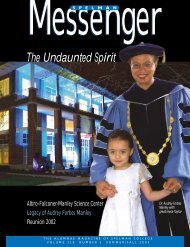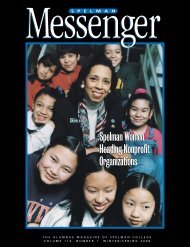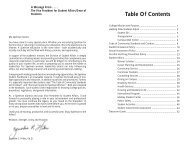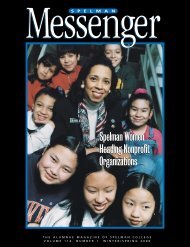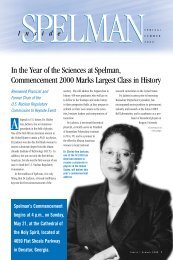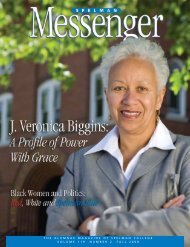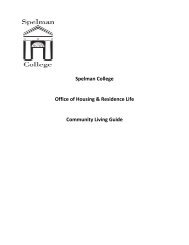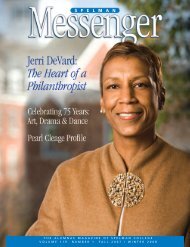Winter 2006 (PDF - Spelman College
Winter 2006 (PDF - Spelman College
Winter 2006 (PDF - Spelman College
Create successful ePaper yourself
Turn your PDF publications into a flip-book with our unique Google optimized e-Paper software.
TWO TIMES THREE<br />
Class of 2009 Boasts Three Sets of Twin Biology Majors<br />
A<br />
ll <strong>Spelman</strong> women are sisters in spirit.<br />
Some <strong>Spelman</strong> women are sisters by<br />
birth. However, for a select few <strong>Spelman</strong><br />
freshmen women, sisterhood has become something<br />
exponential, transcending body and spirit.<br />
These would be three sets of twins. Fall semester,<br />
these three sets of twins presented <strong>Spelman</strong> <strong>College</strong><br />
with a unique equation – all of these freshmen<br />
siblings are biology majors. It would take a<br />
geneticist, a mathematician, and a genealogist<br />
working together to calculate the odds of this<br />
happening at a small, private, historically Black,<br />
women’s college in the laboratories of the Albro-<br />
Manley-Falconer Science Center.<br />
Indeed, Sasha and Asia Curry, Britney and<br />
Whitney Hale, and Megan and Morgan Hall are<br />
excited to be at <strong>Spelman</strong> and glad to share the<br />
experience with a twin sister. Although none of<br />
the girls has close friends or family members<br />
who are alumnae, they were all drawn to <strong>Spelman</strong><br />
for the same reasons. Attending a historically<br />
Black college was high on their list.<br />
Experiencing life in Atlanta was a close second.<br />
“We wanted to go away to college, without<br />
being too far from home,” explained fraternal<br />
twins Asia and Sasha Curry, from Columbus,<br />
Georgia. They felt that <strong>Spelman</strong> would give<br />
them the right balance of independence and<br />
security as they transitioned from adolescence to<br />
adulthood. The sisters share a dormitory room –<br />
and the same class schedule.<br />
Fraternal twins Whitney and Britney Hale<br />
live with a bit more autonomy, as they were frequently<br />
placed in separate classes while growing<br />
up. One year, they even attended separate<br />
schools, but they were clear about attending the<br />
same college. Of all the colleges that accepted<br />
both girls, <strong>Spelman</strong> was tops. While attending<br />
Spelbound, they were drawn to campus life and<br />
recognized the value of attending an HBCU.<br />
“Even though we share a room, it’s not like we<br />
just have to be together all the time, ’cause we<br />
4 I NSIDE S PELMAN<br />
Three sets of twins, all <strong>Spelman</strong> biology majors, are pictured left to right: Britney Hale, Asia Curry,<br />
Megan Hall, Morgan Hall, Sasha Curry and Whitney Hale. Fraternal twins Asia and Sasha Curry are<br />
from Columbus, Ga., and Whitney and Britney Hale come from Lilburn, Ga. Morgan and Megan Hall<br />
are identical twins from Charlotte, N.C. All of the students are contemplating medical careers.<br />
don’t,” said Britney . “I think we each feel very<br />
much like individuals. But we’re still sisters, and<br />
we’re really close.” Staying close to their Lilburn,<br />
Georgia, home was another advantage.<br />
Identical twins Morgan and Megan Hall had<br />
relocated from Phoenix, Arizona, to Charlotte,<br />
North Carolina, when it was time to choose a<br />
college. The sisters visited <strong>Spelman</strong> during a<br />
college weekend and immediately fell in love<br />
with the campus. “This was the place,” said<br />
Morgan. “We like Atlanta, too, and Charlotte is<br />
not too far away,” echoes Megan.<br />
Like any sisters, the twins talk about having<br />
typical sibling rivalries – which one is smarter,<br />
who has the best hair, and which is the shy one<br />
and who’s more outgoing – but their loyalty to<br />
one another is abundantly clear. And, while they<br />
each possess a sense of individuality, there’s no<br />
denying their special bond. Get them all talking<br />
together, and you’ll witness communication on<br />
a uniquely shared wavelength.<br />
The subject of biology invariably comes up.<br />
Multiple births are, after all, on the rise.<br />
Between 1980 and 1999, the overall multiple<br />
birth ratio increased 59 percent, according to<br />
the March of Dimes. The highest rate of fraternal<br />
twins, at about one in 70, occurs among<br />
African Americans. The Yoruba tribe of Nigeria<br />
has the highest twinning rate in the world, with<br />
one set of twins in every 24 births. Among our<br />
Get them all talking together, and you’ll witness communication on a uniquely shared wavelength.<br />
own twins, only the Curry family has an extensive<br />
family history of multiple births. None of<br />
their mothers took fertility drugs.<br />
Is all this what inspired our twins to study<br />
zygotes, genomes and nature vs. nurture? They<br />
would say not really – at least, not yet. For now,<br />
Asia and Sasha want to work with infants or<br />
young children as nurse practitioners or pediatricians.<br />
Britney and Whitney would like to be<br />
physicians, and Morgan and Megan would like<br />
to study obstetrics and gynecology at Emory<br />
University School of Medicine. After school, each<br />
expects to share a practice with her twin.




